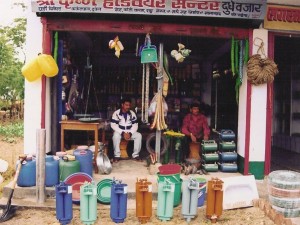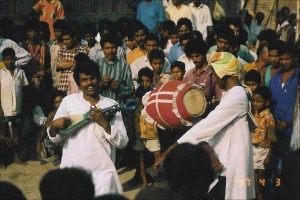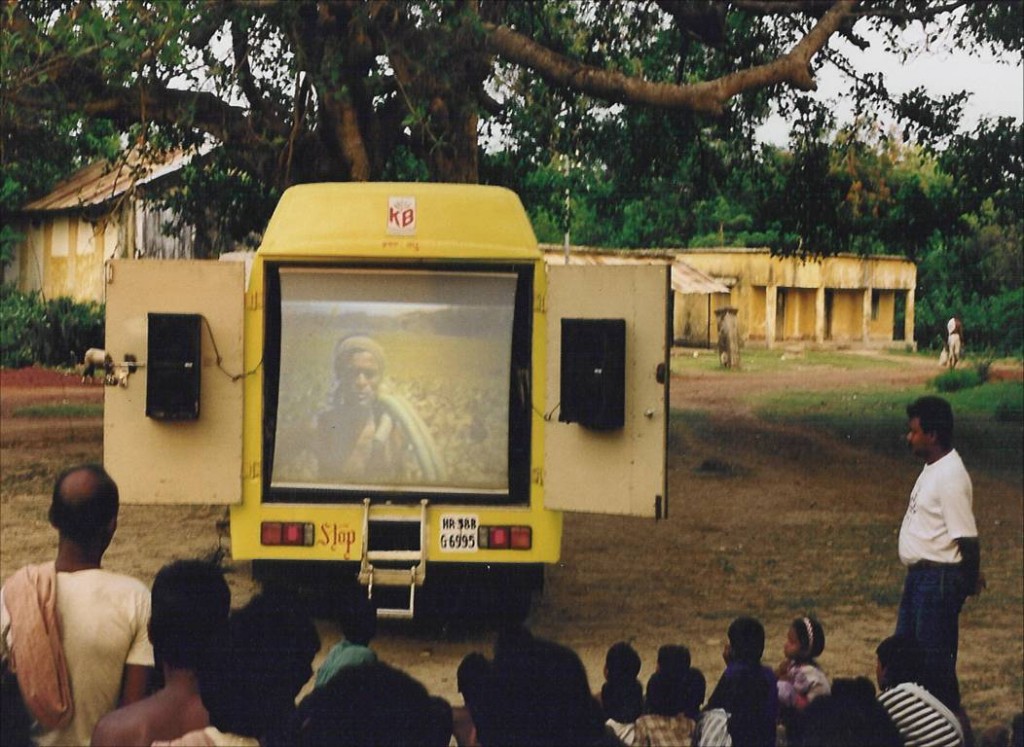In the late 1980’s after launching IDE, I knew we had a big problem. We were convinced that treadle pumps, a simple $25 StairMaster device that could earn a net income of $100 a year or more for one-acre farmers could make a huge impact in Bangladesh. And we knew that market forces were the best way to bring them to scale. But how could we put

them in the hands of millions of small farmers?
We started out by energizing a private sector network of 75 small manufacturers, 2500 village dealers, and 3,000 village well drillers who we trained a three day course with a paper diploma. None of these small rural enterprises could survive without reaching a threshold volume of sales. And nobody in rural villages had heard anything about the treadle pump- it was like a politician with no name recognition.
The first thing we tried was hiring wandering troubadours, were common in rural Bangladesh. They wrote songs about the treadle pump, and performed at farmers’ markets and festivals, where our customers gathered. While the others sang their song and played their musical instruments, one member of the troupe operated a re-circulating demonstration pump, and another handed out pamphlets saying, you want to buy a treadle pump go to Honest Sam the dealer.”

But this didn’t reach the large number of potential customers we were looking for.
So we decided to make a Bollywood Movie about the treadle pump We hired Mrinal Sarkar, who was working for a commercial marketing firm in Dhaka, and he put together a list of the key messages we wanted to communicate about the treadle pump to small farmers. To make a 90 minute Bollywood movie, we hired the top movie director in Bangladesh, the top male lead, and the top female lead, at a total cost of $25,000.
A typical Bollywood movie in Bangladesh has a wedding, a funeral, a near suicide, and lots of singing and dancing. The plot for the first movie was boy meets girl, (lots of singing and dancing) but they can’t get married because her father
is too poor to come up with a dowry. So she falls into the clutches of a dowry bandit (near suicide, more singing and dancing). As the movie nears its climax, the movie suddenly stops. Its intermission time! Now local dealers put
the potential customers they have invited on re-circulating treadle pumps, so they can get the
touch and feel of them.
When the movie resumes, the father meets an old friend, who tells him about the Treadle Pump! So he buys one, earns enough to pay the dowry, and they get married and live happily ever after. It sounds a little hokey, but this movie played to an audience million customers a year. We used a mobile video-van with a generator. With publicity from village dealers and a Barnum and Bailey rickshaw procession with loudspeakers blaring before the show, two to five thousand people showed up at each open-air performance.
Remember, most of our customers couldn’t read or write, and had no access to mass media. The Bollywood movie was a major contributor to IDE’s success in convincing and one and a half million families in rural Bangladesh to buy and use a treadle pump.

Since then, treadle pumps quickly spread to many countries, including India, Nepal, Myanmar, Kenya, Tanzania, Malawi, and Zambia. Well over two and a half million habeen bought by very poor farmers and used to increase their net annual income by more than $250 million a year!
The happy use of Bollywood movies to inform small farmers lives on.
Amitabha Sadangi and the excellent staff of IDE India continue to produce and show them with great success.
Take a look at the highly compressed three minute segment of Lakshmi, a real tear-jerker about a poor family in India who didn’t have enough to eat because their land has no water. Their youngest daughter just about dies from cholera because they have no money for food and Medicinesut the older daughter saves the day. She goes to work at a prosperous farm that uses IDE India’s Krishak Bandhu low cost drip system, brings it back to her family’s farm, and
rapidly transforms her family from paupers into prosperous happy farmers who joyfully sing and dance!

Paul,
What a wonderful example of thinking outside of the box in order to provide marketing and education to your potential customer base. Is there any statistics or information on what the increased uptake in enquiries and sales were before and after a showings? What was the cost of putting on the show? How was that cost recuperated? Is there a tipping point in the a region or area that people started purchasing them because their friends and neighbors were using them and they could see the difference in food output?
great questions, Frank
the tipping point in a village seems to be when enough people have treadle pumps and earn money with them that most families in the village have at least one relative or trusted friend who has had a great experience- because of family connection networks, this usually begins to happen when 10-20% of the families buy and are happy with the product
In addition to the cost of making the movie, there are the costs of two people running the video van and the capital cost of the video van, spread over a million viewers a year. Usually, sales whent up after a showing, particularly when the dealers brought potential customers to the event and used it as a point of sale, but we don’t have controlled research data proving it.
thanks Frank
Paul POlak
Pingback: Philanthropy Daily Digest | Tactical Philanthropy
This is such a great example of community-centered use of the arts, to create dialogue with an audience in forms that are relevant and that resonate. Media that centers message through story, character and plot is often the most effective– and the Bollywood style of film, even though they’re usually fairly escapist and chock full of tragedy, comedy and song in the same work, are particularly effective in carrying messages that educate and highlight social trends. Kudos to your organization for jumping on the B’wood trend…
(Just a clarifying note, though: Bollywood films are specifically those that come out of the Mumbai industry. The film you made in Bangladesh would likely be called a “Dhallywood” film. And Lakshmi sounds like it is in a South Indian language, so also not technically a Bollywood film. But none of this takes away from the great work you’ve done…)
You’re right, Lina, its not strictly speaking “Bollywood” movies, but movies using the Bollywood style.
I’m glad you like what we’ve been doing
paul polak
Great Stuff. But please do better research while writing articles. As a reader has already commented, it’s laughable the use of “Bollywood” everywhere! That’s like saying a documentary film made in Colombia is a Hollywood movie! And the language you’re looking for is Kannada…that’s the language the second movie/clip has been made in.
If you’re writing about development issues in a part of the world, the least your readers would expect is you know the languages spoken there!
Carry on the good work!
Hi Abit amused
thanks for your comments- while I agree that the movies I referred to are not really Bollywood, I think its a little silly to for you to say “thats like saying a documentary film made in Colombia is a Hollywood movie.” After all, the clip I showed was from a movie made in India, not South Africa, and the whole point of this blog was that telling good stories like they do in Bollywood is an effective way of communicating with people about development issues. I’m not writing a research article, I’m writing about my personal experience about practical ways to end poverty
that said, I love a good discussion
thank you for your comment!
Abit perplexed, otherwise known as Paul Polak
That was a brilliant example of a potent communication strategy Paul. Especially when dealing with the BOP consumers, an innovative campaign like this improves the acceptability of the solution offered by a huge margin. Often Public Service & Awareness campaigns have succeeded through such initiatives by filmmakers, theatre groups etc. And the liberal usage of the term Bollywood in this blog is I presume to stress on the point that the film made had a a narrative format similar to that of a typical Bollywood film – a point which I must say is surely not off the mark. I discovered your blog just now Paul and I am surely coming here again. Cheers!
thanks Ashwini
glad yu enjoyed it
paul polak
Stop nitpicking people: I grew up in Bombay and hereby certify ‘Lakshmi’ to be of authentic Bollywood descent:)
Thanks you for this innovative way of spreading the message. Hopefully this idea can be adapted to promote other methods of high output food production like sub-irrigated planters and simplified hydroponics.
Pingback: independent.academia.edu